#pina.posts
Explore tagged Tumblr posts
Text
i have a very real chance of moving somewhere where i'd have a sizeable amount of land to grow food. i promise to obsess about gardening and to use vegetables to their fullest potential 🫡
#i wont know for sure if im going until march so who knows if it'll happen for me#regardless i have been guerilla gardening with pioneer plants for veggies#so even if i dont go i still have more to eat next year#pina.posts
20 notes
·
View notes
Text
What they don't tell you about foraging is that you form a loving relationship with your environment. You don't want to take too much bc you don't want to see them struggle or disappear in the following years. You learn where the snakes live, how the geese play, and that the beavers like to hear you sing. You feel so safe and nurtured.
They also don't tell you that, when the only two grafted pear trees are cut down, it will feel like murder. You will grieve for your fallen family.
30 notes
·
View notes
Note
Happy days!
Something that interests me about ethnobotany is the more pharmaceutical side of it—
How would you get to know the local medicinal/edible plants? I’m very interested in creating my own catalogue, though I have no clue how to do field work T-T
Hi! I'm not super familiar with herbalism, although I have learned a bit here and there for relevant & minor issues that I have.
What you can do is start walking around your area taking pictures of various plants & identifying them via inaturalist (warning: the "what do you see?" suggestions are not always correct, it's up to YOU to look at the leaf shape, vein patterns, flowers, bark, AND etc)
Then you can do research on it once you've correctly identified the plant. temperate.theferns.info and tropical.theferns.info are good places to start bc they source all their information. Check the sources, bc often times source material is not the primary source of info, & the broken telephone effect can lead to extremely bizarre conclusions and/ or the source material can just really suck lol.
I also recommend going on google scholar to see if there are any studies on the medicinal uses of the plants you're looking at. & read those studies bc again, the source material can be worse than useless.
Good luck!!
2 notes
·
View notes
Text
I didn't even think about the birds being poisoned by eating insects and grains sprayed with herbicides and pesticides..
#pina.posts#context: im reading a meta study on the topic of pesticides and herbicides.#i cant believe this shit is still legal considering all the damage it causes#like PLS let cockchafers and wild amaranth return we can just eat them it's not a big deal
6 notes
·
View notes
Text
Nobody asked for my opinion, but here it is anyways: 'invasive' or 'aggressive' species are indictive of ecological disharmony
The occurrence of which IS natural, but always eventually balances out (unless artificially maintained)
Eventually, the plant/ animal/ fungi/ whatever will be predated on and population reduced in size, so it doesn't crowd out entire species or destroy entire ecosystems anymore. This can look like hogs eating large patches of fireweed, or black smut fungus infecting a cherry monocrop.
If left alone, garlic mustard takes approximately 10 years before it's population starts to die down (I'm not sure what leads to the degrowth), and I'm positive that with enough time, an animal or plant disease will move into or evolve to eat it in North America.
Every single species in every single ecosystem has been new or 'invasive' at some point in history. Why it's so important to manage them now is because civilizations have already caused ecological disharmony across the globe, and plenty of species are endangered. So instead of waiting for the destruction phase to pass, ecologists are attempting to artificially predate on these new species, and keep endangered and endemic species and ecosystems alive.
Because the food chain is being absolutely destroyed, and we rely on it for existence.
This is not to say that we should be cruel to invasive species- they are not doing anything wrong. They do not deserve to be curb stomped or shot or fucking tortured like too many people have proudly filmed themselves doing "for the environment".
And what a vast majority of ill-informed people are doing is falling into nazi ideology; they fetishize a specific "primordial" environment untouched by "undesirables", be it invasive species or select groups of people. Which is completely ahistorical.
Most humans alive today have never seen an environment in harmony. Most humans alive today have never seen real topsoil or rock lichen at work or 2000 year old trees.
Besides, the environment is always changing, it will always be changing. A swamp eventually fills and turns into a forest, which can be burned down by lighting, be colonized by primary species, and grow right back into a forest. It's called ecological succession.
Plants are supposed to be eaten and felled. When environments are overgrazed and exploited, they can turn into badlands and dust bowls, which are their own ecological niches, but ones that are hostile to mammals.
And whilst the tiktoker was slightly off, they were right that a lot of what is called 'invasive' actually just means "agricultural pest". Because we actively choose to poison the land with pesticides instead of eating insects like weevils and cockchafers simply out of habit, not bc we can't.
And we actively choose to use herbicides instead of companion planting because it's easier to harvest monocultures. It doesn't give us more food, actually it increases chances of famines
The system we have is fucking stupid.
If you wanna kill an invasive species, then at least eat it or use it in some way. Or kill to protect a specific plant or animal (not it's entire species; it's not possible or sustainable for such little people to do). If it's a plant, you should replace it (grow mycorrhizal fungi & mix it with compost + plant the seeds of a fast-growing native or naturalized species like dandelion).
Killing for the sake of killing.. well, it's really no better than European settlers shooting bison from moving trains.
#invasive species#pina.posts#im too sick to add links but in a few days i will!!#lmk if you want me to forward this post to you when i add links
41 notes
·
View notes
Text
Screenshots from the book Tree Pruning by Alex L. Shigo

Do not injure the collar!



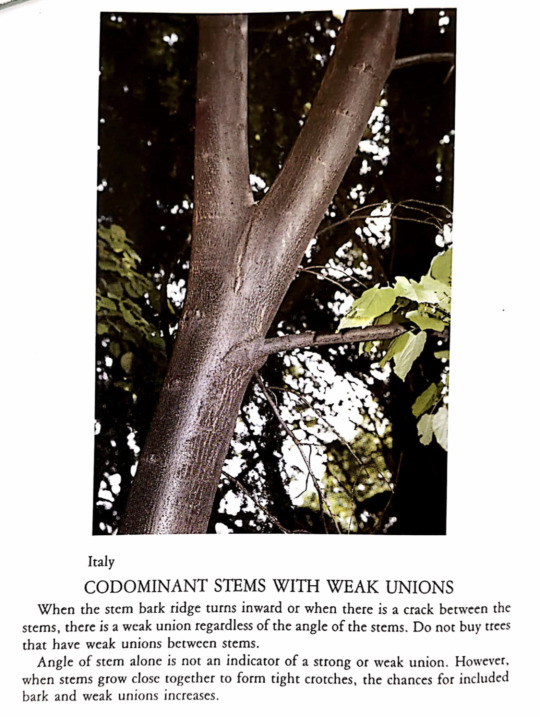
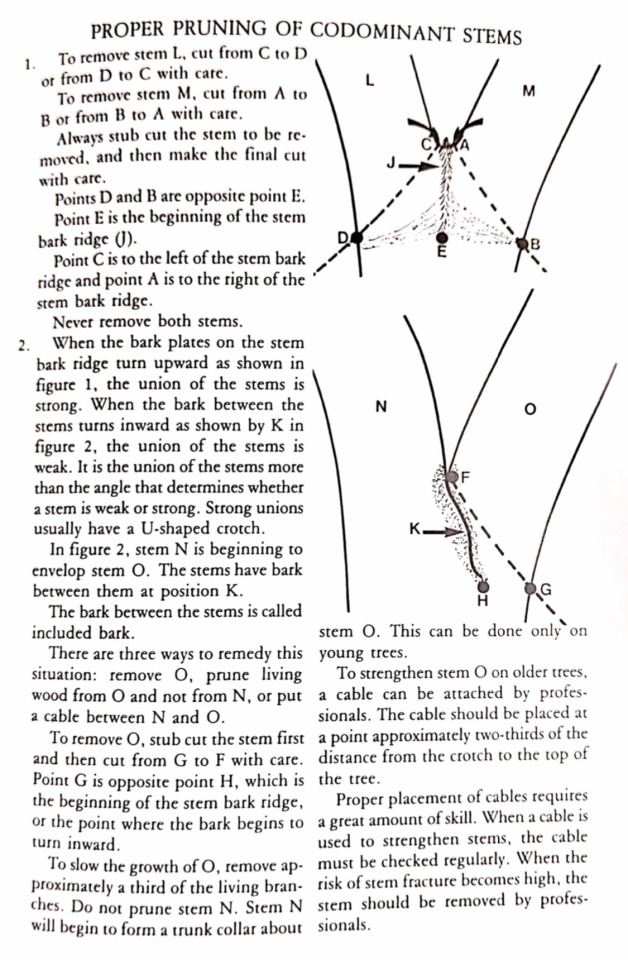


+ one of the most beautifully pruned trees I've ever seen

86 notes
·
View notes
Text
By strategically gating chickens to a certain area for a few weeks, they can eat up all the weeds and scratch the soil surface so it's ready for planting. From there, you can start a food forest by using perennial ground covers, mulch crops (or just any plant to chop and drop), and fruit trees.



The video clip and pics are from this video by Geoff Lawton:
youtube
368 notes
·
View notes
Text
Permaculture circles and forums focus a lot on food forests, but a conventional neat-row monoculture or a forest farm/garden aren't your only options!
There are edible cacti, desert vines, water-inflated tree trunks, etc you can garden in the desert. Shrubs, grasses, moss and lichen you can nurture in the tundra. Wonderful shrubs and grains for prairies and steppe. And countless edible plants you can grow in wetlands if you don't want a floating garden!
Permaculture gardening hack: find out the group of ppl who live or recently lived off the land, either foraging or subsistence farming in your area. Plug in their name (examples: "sardinian elders", "hopi tribe", "melanau people") + "ethnobotany" on google search, and you'll find studies (freely accessible on z-lib.org or sci-hub.st) with dozens of native plant species that can be used for food, medicine, etc. You don't have to have 100% native plants either, look for plants from other climate zones similar to yours!
For example: Japan (minus Okinawa) and Ontario have similar climates. Southern Yemen and Arizona are similar to each other, too. Just be sure not to bring any aggressive-growing plants into your environment, like bringing black cherries from Ontario to Japan would be a terrible idea.
A food forest is a beautiful idea, but you'll have a much more successful time if you work with your environment rather than against it.
Plus, you'll get to produce and eat hundreds of delicious plant species you'd never be able to buy! Think of the sxusem (ice cream) you could make with soapberries and cloudberries in the arctic circle, or the candy you can make with giant barrel cactus in the desert 🤤
350 notes
·
View notes
Text

(source) The Miyawaki method has a high success rate, and can create a dense forest in under 7 years! In addition to planting a wide variety of native plant species (over 50), the Miyawaki method fertilizes the soil with manure and rice husks (among other materials), and densely planted saplings (3-4 plants per metre square).
During this early period, the plantings compete with each other for space and access to light and water—a battle that encourages much faster growth.
Here's a beginners guide:
411 notes
·
View notes
Text
How to sustainably cultivate annuals, like popular grains (corn, rice, wheat, etc)?

Plenty of indigenous farmers across the world grow annuals and use slash-and-burn (swidden) techniques, but they do it sustainably, which entails using the land for a short period of time, and letting it regenerate for 5-20 years. This is called shifting cultivation!
It's not just important for sustainability, but for cultural reasons as well (such as the Jewish practice called Shmita). Just as people need rest, so does the land!
The longer a field is cropped, the greater the loss of soil organic matter, cation-exchange-capacity and in nitrogen and phosphorus, the greater the increase in acidity, the more likely soil porosity and infiltration capacity is reduced and the greater the loss of seeds of naturally occurring plant species from soil seed banks. In a stable shifting cultivation system, the fallow is long enough for the natural vegetation to recover to the state that it was in before it was cleared, and for the soil to recover to the condition it was in before cropping began. During fallow periods soil temperatures are lower, wind and water erosion is much reduced, nutrient cycling becomes closed again, nutrients are extracted from the subsoil, soil fauna decreases, acidity is reduced, soil structure, texture and moisture characteristics improve and seed banks are replenished.
Key parts of regeneration include leaving the immediate surroundings alone (so like, the first plot shouldn't be touching the second plot, for example) so animals can carry over seeds from uncultivated land. (Though the land isn't abandoned; wild plants and perennials can be foraged, and the open fields attract animals that are easily hunted)
I'm most familiar with shifting cultivation in Mizoram, but initially my interest in shifting cultivation came from Amazonian indigenous groups, as well as the Mende and Loma people of Western Africa because of the slash-and-char practices! (which I've talked about in this post)
Of course, because of private property and the decimation of nomadic lifestyles across the globe, most of us can't just burn down an acre for a year's grain before moving on. There have been a few farmers who have grown food forests (aka agroforestry), and successfully do shifting cultivation on a small scale for their grains! Here's are some drawn examples:


This method can be used in addition to the use of natural fertilizers (manure, compost, etc) and annual cover crops (which will die as native plants are reintroduced naturally; alternatively, native ground covers can be used)
Sometimes, instead of slashing and burning plants, animals are gated in the area and left to eat the vegetation to prepare it for planting!

Traditional & cultural examples of swidden farming include: milpa (Maya), jhum/ jhoom (Zomia region), chitemene (Zambian), reutbergwirtschaft (German), kaingin (Filipino), talun-kebun (Javanese), and so much more!
While they all fall under the swidden definition, they all have unique components to them! Like in Zambia and Western Java, trees are coppiced or pollarded instead of completely chopped down (which is similar to "inga alley cropping", which involves planting alleys of trees and heavily pruning them before growing annuals).
Another variation of swidden farming is the use of slash-and-char instead of slash-and-burn, which I mentioned earlier. It benefits soil and plant health in incredible ways!
246 notes
·
View notes
Text
This short chapter on indigenous PNW tech includes some informative drawings on fishing technology!





135 notes
·
View notes
Text
Why waste the rain?
I'm obsessed with gardening systems that utilize rainwater without the use of barrels or cisterns. My ultimate fav is using bioswales to catch and filter stormwater on the street.


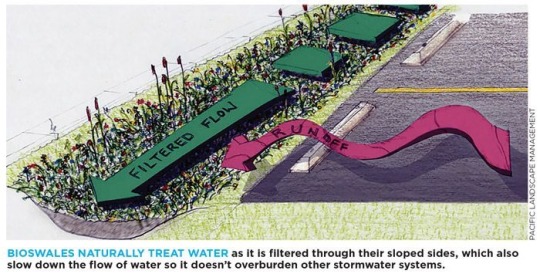
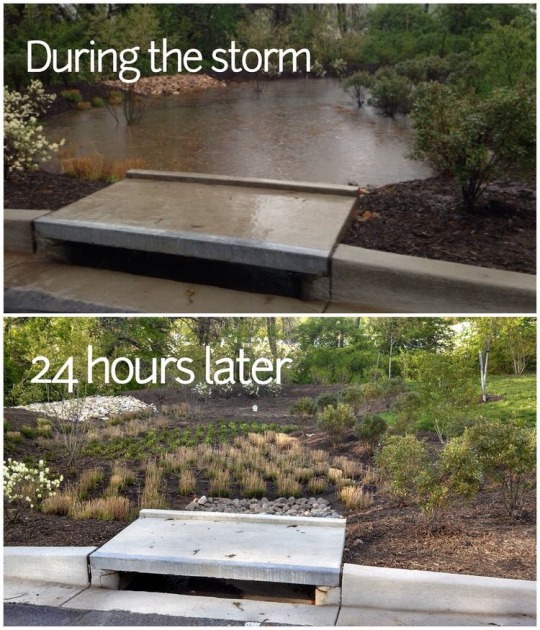

Fun addition: Dams that utilize trees to catch dirt/ stop erosion, and prevent disaster that can come from broken dams.

8K notes
·
View notes
Text
Push & Pull Agriculture
@badboipointallocator introduced me to this method, a way to deter pests from crops without killing them!
Push–pull technology is an intercropping strategy for controlling agricultural pests by using repellent "push" plants and trap "pull" plants.
[...] intercropping a cereal crop with a repellent intercrop such as Desmodium uncinatum (silverleaf) (push), with an attractive trap plant such as Napier grass (pull) planted as a border crop around this intercrop. Gravid stemborer females are repelled from the main crop and are simultaneously attracted to the trap crop. (wikipedia)
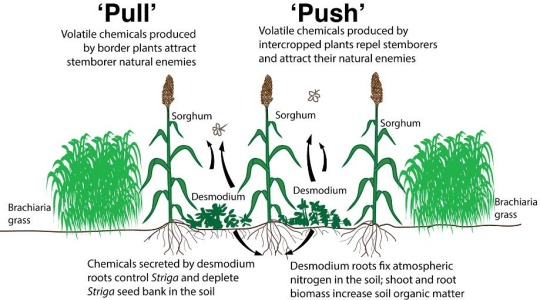
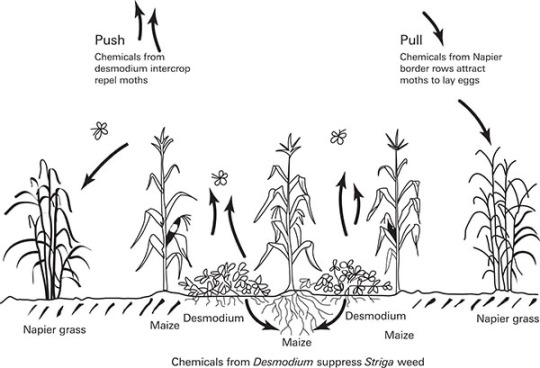
While I haven't tested out this concept in full, I have used nasturtiums as a trap (pull) plant to save my tomatoes from certain pests!
Of course, every staple crop requires different push and pull plants (and preferably a variety among those plant species, too), but it looks like a fun project to work on.
For example, Turnera Subulata attracts ants, while lemongrass repels them. While ants typically aren't a pest to crops, their presence can reduce pollination rates and ants tend to farm aphids, whom do damage crops.
For example, if ants are a problem among tomato plants, you can plant lemongrass between the tomatoes, while turnera subulata goes around the tomatoes and lemongrass (with a bit of distance between)
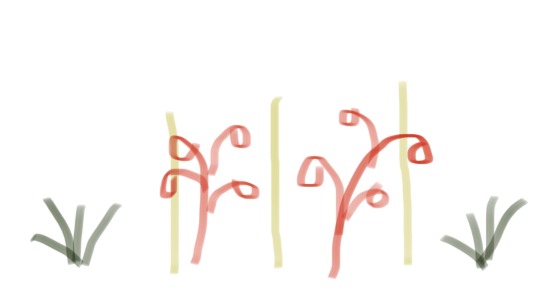
75 notes
·
View notes
Text
A very short, yet pretty thorough introduction to RPM (root production method)
The RPM system (Root Production Method) is a multistep production system of container tree production that places primary emphasis on the root system because the root system ultimately determines the tree's survival and performance in its outplanted environment. This particular container production system has been developed to facilitate volume production, in a high-quality tree with good height-caliper balance. Approximately 80% of our production consists of native trees, many of which present transplanting difficulties using conventional nursery growing systems.
It's basically a method of exposing sapling roots to the air to produce strong fibrous roots (this method is called air root pruning), combined with specified selections of seeds and the growing medium. The benefits are trees that grow extremely quickly!
With air-pruning, a plant’s roots come in contact with the air as they grow. It is a natural process where the individual root tip dries out and stops growing. The plant responds to this by producing even more fibrous lateral roots. What you end up with is a healthy plant with a dense fibrous root system, ready to take nutrients and water to your plant.


(source of the second pic)
Some excerpts from the original paper:
Superior trees growing on specific sites are selected for seed collection. Experience has taught us that most species have ecotypes that are site specific. We look towards the wetlands or floodplains as a prime seed source for native tree species that are found growing on both wetland and upland sites. Since they have evolved under stress we find they will consistently outperform their upland counterparts on virtually any site, particularly on highly stressed sites.
Our standard growing medium consists of 40% composted rice hulls, 40% pine bark, 20% sand plus slow release fertilizer, micronutrients, and a wetting agent. The medium is also inoculated with mycorrhizae spores.
Thank you to @cernoid-leporidae for introducing me to RPM and sending me excerpts from Farming the Woods


314 notes
·
View notes
Text
The ADASR is learning about and restoring sustainable agricultural systems in the Negev desert. Their research primarily focuses on molding the land to catch and utilize rainwater, rather than typical irrigation which can deplete water reserves or increase the salinity of the soil and further errode the land (and feed into the loop of desertification).
Though most of these methods are practiced around the world- stone terraces to slow runoff, channels/ canals to guide water along the landscape,

creating dips in the land to create temporary ponds,

and often, a combination off all three-

something unique to the area (thought to be an invention by ancient Nabataeans, and still utilized by Bedouins) are mounds of rocks called Tuleiat el-Anab.

These mounds initally appeared to be insignificant, like misplaced gravel, the prevailing theory is that these mounds slow down water movement within a terraced system.
Yet some scientists (most notably Zibold) think these mounds collect and utilize morning dew, as if these tiny mounds of rocks are a precursor to stone air wells.
These rock mounds, at the very least, act as a mulch and shield the soil from the sun, reducing evaporation.
Rock mounds are currently used by nomadic Bedouin communties, from which the students of ADASR are learning from.

269 notes
·
View notes
Text
Horse manure hotbed by asparaguspea
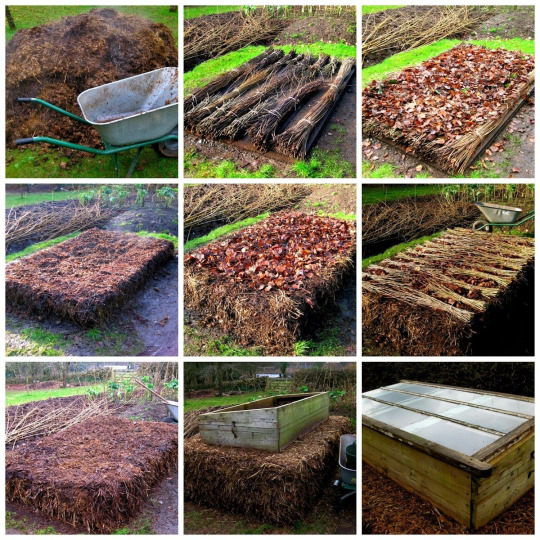
Basically, just piling up twigs or straw, leaves, and fresh manure to create a warm hotbed for winter gardening, or early sowing!
16 notes
·
View notes